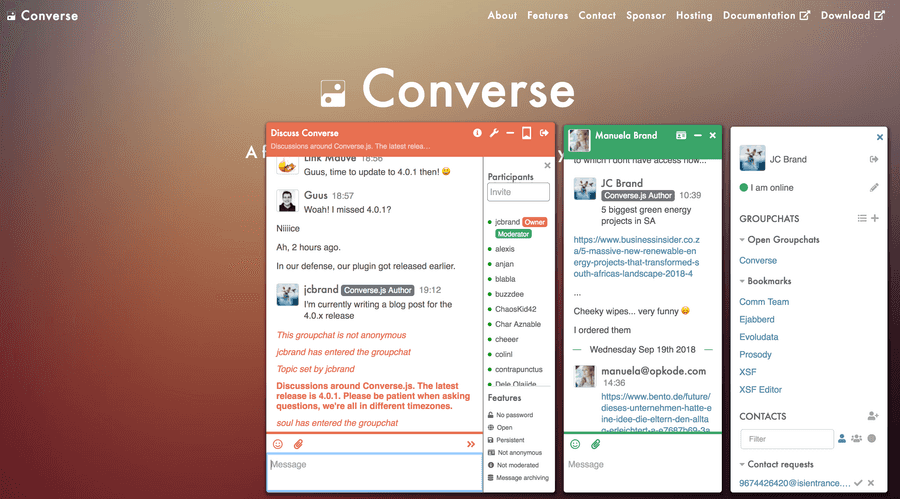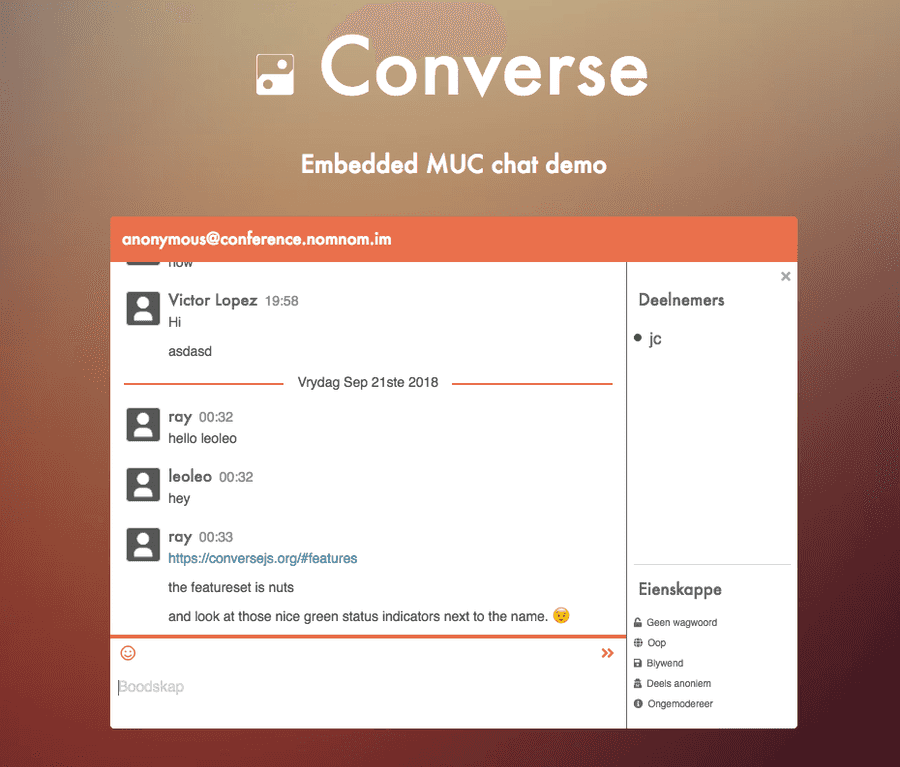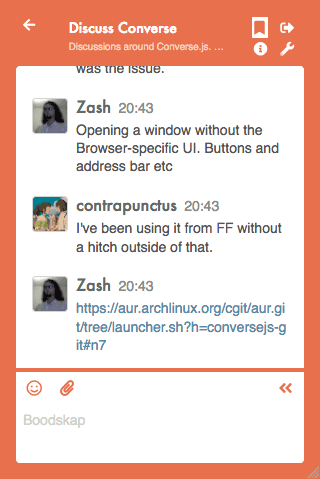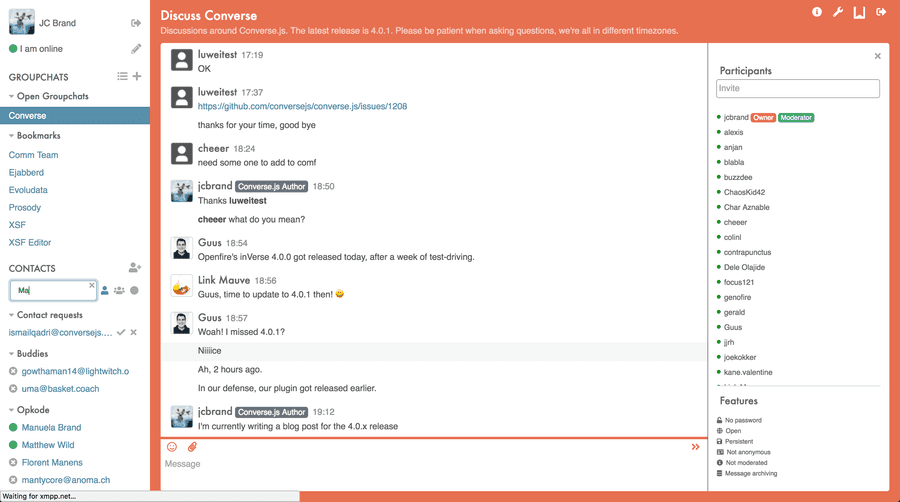After more than 7 months of active development, Converse 4 has finally been released.
Converse is an open source XMPP-based chat client written in JavaScript and which runs in your browser.
This release contains lots of highlights, including rewriting the UI to use Bootstrap 4, support for OMEMO Encryption of private messages, message corrections and file-sharing via HTTP file upload.
XMPP is an IETF standardized messaging and presence protocol with multiple independent server and client implementations.
Unlike other popular open source teamchat applications like Mattermost and Rocket.chat, Converse doesn’t depend on any particular server (e.g. backend) application. Any XMPP server which supports the relevant extensions (aka XEPs) will do.
Converse is 100% front-end JavaScript and CSS. The only backend you need is an XMPP server, which you can either set up and host yourself or you can sign up on an existing one.
XMPP’s killer feature
XMPP allows for something called federation. Even if you’ve never
heard the word being used in this context, you already know what it
means if you’ve used email.
When you sign up for an email account from one provider (for example Gmail, Fastmail or Kolab), you can still send emails to people who have accounts at other providers. That’s because Email is also federated.
A federated protocol allows you to communicate with user-accounts on foreign hosts. The network is decentralized between many providers (who all adhere to a common protocol), instead of being controlled by a single centralized behemoth (like Facebook, Twitter or LinkedIn).
Federation is getting quite a lot of renewed attention lately, in large part due to the hype around the federated social networking site Mastodon which is based on the recently published ActivityPub standard.
You’re not forced to federate when running an XMPP server for your organisation, friends or family, and sometimes it makes sense not to.
However it’s in my opinion the killer feature of XMPP and one of the main reasons why I’m working on Converse.
Federation implies user-freedom and user-choice, and it’s one thing that Slack or Discord simply cannot do. Not because it’s not technically feasible, but because their business models, based on user lock-in and control, don’t allow it.
It’s also something which the open source Slack-alikes like Mattermost and Rocket.chat don’t have.
I believe people should have the freedom to use the chat app of their choice, while still being able to effectively communicate with their contacts who prefer to use a different chat app.
XMPP and federation can make this a reality.
In a world of federated chat apps, some people will use a commandline client like Poezio, a desktop client like Dino or a mobile client like Conversations (or a combination of all three).
There will also be a growing need for web-based chat clients, and that’s were Converse comes in.
Federation not only provides choice between chat clients, it can also foster inter-departmental or inter-organisational communication.
In Germany, where I currently live, there is a lot of talk of digitization of government. Government bureaucracy often consists of various different departments who need coordinate and send resources around.
The same of course applies to large enterprises.
A decentralized and federation communications protocol can play a large role here, and I’m not just talking about chat apps.
The Salut à Toi project has shown how you can create a decentralized and federated issue tracker, while Movim has blogging and microblogging capabilities, all based on XMPP.
Converse’s history
Converse was originally developed at Syslab.com as part of a web-based intranet for the Star Alliance airline group.
Back then it was developed as a Gtalk-like popover chat, like you still see on LinkedIn.
After open sourcing it, my initial goal was to make it as configurable and capable as possible, so that it could be used in any website in almost any conceivable manner.
A powerful plugin architecture and API was added, which allows you to add or remove features and change just about any behaviour.
Over time, as the project matured and people started using it, it became clear that there are many more usecases for a webchat than simply popover chats.
Full-page teamchat apps like Slack also became spectacularly successful.
I subsequently updated Converse to have different “view modes”, which enable you to use it in different ways, depending on your needs.
The focus also shifted slightly from presenting it merely as something to be integrated into an existing website, to showing that it can be an independent chat client in its own right.
There is the “overlay” mode, which matches the original UX design:
Then there are the “embedded” and “mobile” modes:
And lastly there’s the “fullscreen” mode, more similar in UX to teamchat applications like Slack and Discord.
All these modes use the same JavaScript and CSS, and you can switch between the view modes. Currently it’s not possible to do so without reloading the page, but we’ll work on making that possible as well.
Working on Converse fulltime
In the beginning of this year, I decided to drop other work commitments and to dedicate this year fully to working on Converse and to see where that leads me.
This was in many ways a daunting leap into the unknown, because I knew I would now have to find more ways to try and earn a living off this work.
I’ve been doing consulting and custom development around Converse for a few years, but never exclusively. I also wasn’t sure what business model I should adopt.
Consulting? Proprietary plugins? Hosting? Sponsorships?
I decided to first just focus on building the product, to make Converse better, and not to worry about making money just yet.
In part this is due to my bias as engineer, and being out of my comfort zone when trying to monetize something.
But I also believe that a compelling product, that users love, can go a long way to helping you come up with a sustainable and feasible business model. I hoped that along the way people might appear who would help me realize this vision.
It’s the "if you build it, they will come" approach.
During this time, various people did in fact reach out to me and some of them funded further development.
I also got enough consulting and development gigs to keep the lights on and to keep me going.
Marc Laporte from Wikisuite funded many hours of work moving the UI to Bootstrap 4, and then some more.
Converse will become part of Wikisuite, together with the OpenFire XMPP server.
He gave me valuable advice on how to make a living off open source software and encouraged me to make the leap.
I also got a call from Happy Dev, who needed a federated webchat solution for their Startin’ Blox project (more on that in future posts). We’re doing some interesting work for them, which addresses some pain points with XMPP and will be of benefit to the larger community.
Nicolas Vèrité, of Nayego funded responsiveness improvements while individuals like Christian Weiske and Rafael Munoz generously contributed funds as well.
Some people also backed me on Patreon and Liberapay.
Every gig or donation I got was for me a vote of confidence, and gave me the opportunity to stay the course and continue down this path.
Besides monetary contributions, many people contribute features and bugfixes, and hang out in the Converse chatroom, answering questions, providing their expertise and generally making it a more lively, interesting place.
In many ways this release would not have been possible without all of their contributions, and I therefore dedicate it to everyone who has contributed money, time or energy (all interchangeable actually) to this project and therefore has contributed to its success. Thank you!
The archetypal nature of free software communities
Over the last year I’ve witnessed the Converse project becoming a community and not just a collection of software. It’s a subset of the larger XMPP community and one that overlaps with various other XMPP and free software related communities.
This has been for me one of the most magical and satisfying things about being involved in open source.
Community is archetypally feminine1, in the sense that it’s something that cannot be enforced, demanded or created out of domination, control or rule-making (which are archetypally masculine attributes). Instead, it’s something that arises seemingly spontaneously, after an unknown period of gestation and only after the groundwork has been laid and perhaps after enough loving care and attention has been provided. Its organic, emergent nature means that it doesn’t strictly adhere to top-down schedules and deadlines.
My wife and I, both interested and fascinated by Jungian archetypes, are amazed at the archetypally feminine aspects of her pregnancy, which is soon coming to an end (and new beginning).
As much as we as a society try to control, monitor and manage a pregnancy, if you decide to have a natural birth, then you’re waiting for it to happen on its own accord, and aren’t able to impose your will and deadlines on it.
In some ways the same is true for a software commons. A commons is a shared resource which no-one has exclusive control or ownership of. This lack of ownership and exclusive control makes people resilient against the software being used as a tool for domination and exploitation. It also means that the project (i.e. the software and its surrounding community) is more organic.
This coming together between software as inanimate artifact, and community as a living breathing organic hive-mind, brings to mind a Taoist union of Yin and Yang, the archetypal feminine and masculine.
Incidentally, the Converse logo is a stylized Yin Yang symbol. Many people don’t know this because I did such a poor job of designing it. I’m still looking for a better logo design which encapsulates these principles of harmony between community and software.
What does the future hold for Converse?
This has turned out to be a relatively strange blog post, where I wanted to originally write about the features of the 4.0 release and instead took an ever more esoteric detour.
In any case, let’s try to salvage what’s left of the original intent by closing off with what’s in the pipeline for future releases.
Message markup
Converse still doesn’t support markdown-like syntax highlighting. This is a top-priority for future releases.
Voice messages
With voice messages I mean sending voice recordings, not audio streaming (although that might also come sometime).
My wife, friends and family use voice messages (via Conversations) a lot and I believe they’d be a useful addition to Converse as well.
Email notifications
One area where XMPP needs to improve is sending (email) notifications when you’re offline and mentioned in a groupchat. XMPP’s groupchat presence rules have made this difficult. Together with Happy Dev and Matthew Wild from Prosody I’m working on a potential solution.
Some of the code for this solution is already in Converse, and we’ll submit a specification for standardization (a so-called XEP) once the time is right.
Making Converse a progressive web-app
There are various features of so-called progressive web apps which will make Converse a much better client, such as:
- Push notifications even when Converse is not open.
- Using IndexedDB for caching, thereby avoiding storage limitations of
localStorageandsessionStorage. - Offline support for editing and sending messages.
Persistent login
Other webchat clients like Mattermost and Rocket.chat can keep you constantly logged in via cookies or perhaps JWT.
XMPP-authentication isn’t cookie-based and it’s not safe to store user credentials in the browser cache. This means that users often have to login anew when they open Converse in a browser tab.
The Credential Management API might help here, but it’s still Chrome-only and I haven’t studied it enough to know whether it’s a solution.
Another approach is to allow Converse to also use authentication cookies by adding support for them to XMPP servers.
Matthew Wild has already added support for cookie authentication to Prosody but more work needs to be done to get this working on conversejs.org.
OAuth-based login
Converse already supports OAuth-based login, but it’s not yet deployed to conversejs.org and more work can be done to fetch and show your user profile from the OAuth provider.
Let’s build this together
There are many more features and improvements planned, too many to list here.
The health and sustainability of this project depends in large part on its community of users and contributors.
The community is invaluable in finding bugs, making feature suggestions and doing quality control that would otherwise not be possible given the circumstances.
Another important requirement for the long-term health and viability of the project is funding.
I and others are spending much of our own time working on Converse, but to make this project sustainable we need more funding. Either through donations (e.g. Patreon), funded feature requests or by using my services as an XMPP and Converse consultant and developer.
Another option is allowing an employee to spend some of their paid time on helping the project with bugfixes and other contributions.
This applies in general to open source projects. Companies derive immense value from them, and the vast majority don’t have wealthy corporate backers like Facebook and Google.
I also intend to soon start offering hosted solutions for organisations who want to use Converse as their preferred teamchat solution.
Please reach out to me here if you’re interested.
References
-
I’ve been thinking a lot about archetypes (and Jungian-analysis) the last while, in part due of various books I’ve read that deal (partly) with the topic.
Recommended reading, if you’re interested:
Hello, I'm JC Brand, software developer and consultant.
I have decades of experience working with open source software, for governments, small startups and large corporates.
I created and maintain Converse, a popular XMPP chat client.
I can help you integrate chat and instant messaging features into your website or intranet.
Don't hesitate to contact me if you'd like to connect.

.jpg)



